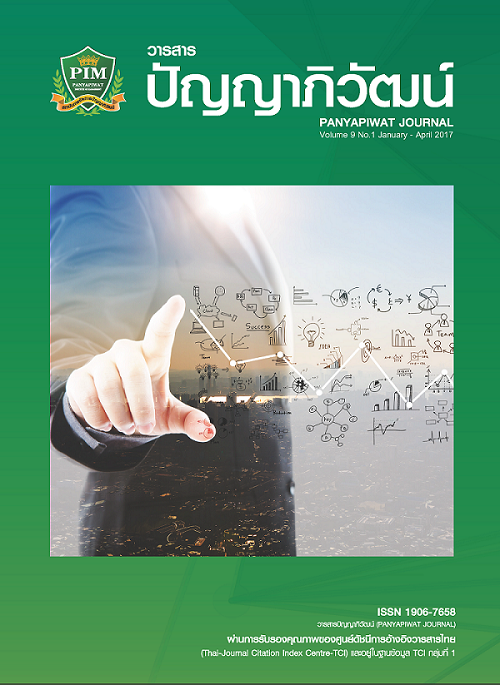ส่วนประสมทางการตลาดที่มีต่อการตัดสินใจซื้อหัตถกรรมสิ่งทอ จากภูมิปัญญาชนเผ่าชาติพันธุ์ล้านนา: ชนเผ่าปกาเกอะญอ
Main Article Content
Abstract
การวิจัยมีจุดประสงค์เพื่อศึกษาส่วนประสมทางการตลาดที่มีผลต่อพฤติกรรมการตัดสินใจซื้อหัตถกรรมสิ่งทอจากภูมิปัญญาชนเผ่าปกาเกอะญอ โดยใช้แบบสอบถามในการรวบรวมข้อมูล กลุ่มตัวอย่างได้แก่ บุคคลที่มีอายุตั้งแต่ 20 ปีขึ้นไป ที่เคยมีประสบการณ์ในการซื้อสินค้าหัตถกรรมสิ่งทอชนเผ่าปกาเกอะญอในเขตอำเภอเมือง จังหวัดเชียงใหม่ ใช้การสุ่มตัวอย่างแบบกำหนดจำนวนตัวอย่าง จำนวน 250 ราย พบว่า ปัจจัยส่วนประสมทางการตลาดที่มีต่อการตัดสินใจซื้อสินค้าหัตถกรรมสิ่งทอจากภูมิปัญญาชนเผ่าปกาเกอะญอ พบว่า ส่วนประสมทางการตลาดในภาพรวมให้ความสำคัญอยู่ในระดับความสำคัญมาก (X = 6.08, S.D. = 0.68) ซึ่งด้านผลิตภัณฑ์ให้ความสำคัญระดับมากที่สุด (X = 6.55, S.D. = 0.51) ด้านราคาให้ความสำคัญระดับค่อนข้างมาก (X = 5.22, S.D. = 0.68) ด้านช่องทางการจัดจำหน่ายให้ความสำคัญระดับมาก (X = 6.15, S.D. = 0.66) และด้านการส่งเสริมทางการตลาดให้ความสำคัญระดับมากที่สุด (X = 6.38, S.D. = 0.62) การทดสอบสมมติฐานของผู้บริโภคที่มีลักษณะข้อมูลส่วนบุคคลแตกต่างกันในด้านอายุ ระดับการศึกษา อาชีพ และรายได้เฉลี่ยต่อเดือน มีค่าเฉลี่ยความสำคัญต่อส่วนประสมทางการตลาดแตกต่างกัน ที่ระดับนัยสำคัญทางสถิติ 0.05 แนวทางการพัฒนาส่วนประสมทางการตลาดที่มีต่อการตัดสินใจซื้อหัตถกรรมสิ่งทอจากภูมิปัญญาชนเผ่าชาติพันธุ์ล้านนา: ชนเผ่าปกาเกอะญอ ควรมุ่งเน้นดังนี้ 1) การมุ่งผลิตโดยเน้นคุณภาพ ผลิตภัณฑ์หลากหลาย 2) ควรเน้นและคงอัตลักษณ์ เอกลักษณ์ของผลิตภัณฑ์สิ่งทอแบบดั้งเดิม ลวดลาย สีสันที่สามารถแสดงถึงศิลปะท้องถิ่นของชนเผ่าปกาเกอะญอ 3) บรรจุภัณฑ์สวยงาม 4) การมีจำหน่ายในระบบ E-Commerce และผ่านสื่อสังคมออนไลน์ 5) ส่งเสริมทางการตลาดร่วมกับหน่วยงานภาครัฐบาล เอกชน
This research aims to study the marketing mix factors that affect buying decision of textile handicraft from Lanna’s ethnic wisdom of Pgazkoenyau. Questionnaires were used to collect data. The sample total 250 samples were individual person age more than 20 years old that have experience in purchasing textile handicraft of Pgazkoenyau in Muang district, Chiang Mai province. The marketing mix factors that affect buying decision of textile handicraft from Lanna’s ethnic wisdom of Pgazhoenyau showed the result that the overall importance is in the very important level (X = 6.08, S.D. = 0.68), which product factor is at the highest level (X = 6.55, S.D. = 0.51), price factor is at quite high level (X = 5.22, S.D. = 0.68), place and channel of distribution factor is at high level (X = 6.15, S.D. = 0.66), and marketing promotion is at the highest level (X = 6.38, S.D. = 0.62). The hypothesis examination of the consumer with the different general information in terms of age, education level, occupation, and average monthly income, showed the important average towards the different marketing mix at the level of significant of 0.05. In order to develop the marketing mix factors that affect buying decision of textile handicraft from Lanna’s ethnic wisdom of Pgazkoenyau, it is necessary to focus on: 1) The quality of variety range of products. 2) Maintain the identity and uniqueness of the traditional textile, pattern, color that show the local art of Pgazkoenyau’s tribe. 3) Nice and beautiful packaging. 4) Available to purchase online via E-Commerce and social media. And 5) promote about the marking in cooperating with both public and private sectors.
Article Details
I and co-author(s) certify that articles of this proposal had not yet been published and is not in the process of publication in journals or other published sources. I and co-author accept the rules of the manuscript consideration. Both agree that the editors have the right to consider and make recommendations to the appropriate source. With this rights offering articles that have been published to Panyapiwat Institute of Management. If there is a claim of copyright infringement on the part of the text or graphics that appear in the article. I and co-author(s) agree on sole responsibility.
References
Belch, G. E. & Belch, M. A. (2001). Advertising and Promotion: An Integrated Marketing Communications Perspective (4th ed.). Singapore: Irwin/McGraw Hill.
Chumoun, M. (2010). Development of Marketing Management of Hand Wooven Cotton Products: Baan Don Luang Hand Wooven Cotton, Tumbol Mae Rang, Aumphur Pa Sang, Lumphun Province. Department of Marketing, Chiang Mai Rajabhat University. [in Thai]
Darawong, C. (2015). Knowledge Management in Product Development Teams for New Product Success. University of the Thai Chamber of Commerce Journal, 35(2), 161-173. [in Thai]
Kanthanatee, S., Plengwittaya, A. & Kodsombat, S. (2009). Analysis of the Product and Packaging of Value-Added Silk Products at Ban Tawon, Chalerm Prakiet District, Buri Ram. Academic Journal of Association of Private Higher Education Institutions of Thailand, 15(1), 25-39. [in Thai]
Klairak, T. (2007). Behavior and Decision Making on Purchasing Silk of Consumer in Ayutthaya Province. MBA Thesis in Marketing, Phranakhon Si Ayutthaya Rajabhat University. [in Thai]
Limrattanamongkol, P. & Sutamuang, K. (2012). Decision of Purchasing Hand Woven Cotton of Generation Y in Bangkok Area. The journal of financial, investment, marketing and business administration, 2(3), 42-54. [in Thai]
Loudon, D. & Della Bitta, A. J. (1988). Consumer Behavior: Concepts and Application (3rd ed.). New York: McGraw Hill.
McCarthy, E. J. & Perreault, W. D., Jr. (1996). Basic marketing: A global managerial approach(12th ed.). Chicago: Irwin.
Phufa (Non-Profit Organization). (2003). The Job Promotion Project Initiated by Her Royal Highness Princess Maha Chakri Sirindhorn. Retrieved March 23, 2016, from http://www.phufa.org/about_project.php [in Thai]
Pongwiritthon, R. & Pakvipas, P. (2013). Guidelines for Sustainable Tribe Cultural Tourism Development.Journal of Community Development Research, Naresuan University, 6(1), 42-59. [in Thai]
Pongwiritthon, R. (2015). Creating Shared Value in Thai SMEs for Competitive Advantage. University of the Thai Chamber of Commerce Journal, 35(3), 164-178. [in Thai]
Pongwiritthon, R. (2015). Guidelines for Developing Community Products for a Sustainable and Creative Economy: A Case Study of Ban Mae Pu-ka, Sankamphang, Chiang Mai. University of the Thai Chamber of Commerce Journal, 35(2), 44-58. [in Thai]
Ruechutakul, M. (2006). The Factor Affecting the Behavior in Decision Making on Purchasing Silk Product of One Tambol One Product of the Consumer in Nakhonratchasima Province. Thesis of Faculty of Management, University of Kakhon Ratchasima. [in Thai]
Siripan, P. (2005). The Factor Associated to the Purchasing Decision of Silk Product of the Consumer. MBA Thesis in Marketing, Phranakhon Si Ayutthaya Rajabhat University. [in Thai]
Sprott, D. E., Manning, K. C. & Miyazaki, A. D. (2003). Grocery Price Setting and Quantity Surcharges. Journal of Marketing, 67(July), 34-46.
Srinakharinwirot University. (2012). The Wisdom Category on Fabric Weaving. Retrieved January 31, 2016, from http://student.swu.ac.th/hm471010393/culture.htm [in Thai]
The Office of Strategy Management Upper Northern Provincial Cluster 1. (2012). The Strategy of Upper Northern Provincial Cluster (Lanna). Retrieved April 28, 2016, from http://region3.prd.go.th/strategy/ [in Thai]
Theeravanich, R. (2008). Behaviors and Marketing Factors Affecting Buying/Using Hand-Woven Cotton for Clothing. Thai National AGRIS Centre, Kasetsart University, Bangkhen Campus. [in Thai]


